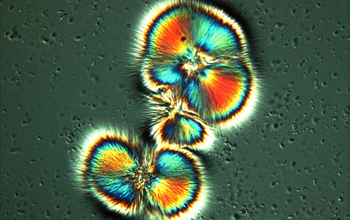Multimedia Gallery
"Microbe vs. Mineral - A Life and Death Struggle in the Desert"
"Microbe vs. Mineral - A Life and Death Struggle in the Desert," by Michael P. Zach, University of Wisconsin-Stevens Point.
Although the bursts of rainbow colors in this photograph are mesmerizing, microbes fight for their lives in the background. Zach, a chemist, snapped this image of a salt sample he collected in a hot, arid valley near Death Valley National Park in California. He crushed the salt, placed it under a microscope slide and added a drop of water. Suddenly a slew of microbes came to life as the salt crystals dissolved. Then when the water started evaporating, he took a picture. The colors come from light passing through the growing crystals, which act like prisms.
The small specks in the background are living halophilic bacteria. The rainbow crystal clusters form as the water evaporates and may eventually overgrow the bacteria. Organic materials are known to adhere to mineral surfaces, thus sealing the crystal surface from further growth. If the microbes have not produced enough organic material to coat and inhibit crystal growth, they could be trapped within the growing crystals. If that happens, they would be trapped until the next rainy season or perhaps.the next million years until a cosmic ray "does them in." But if the microbes produce the right adsorbates and in sufficient quantities to inhibit the crystal growth, they can continue to live and reproduce in a supersaturated brine solution. Zach says the life and death struggle between microbes and the interruption of the normal crystallization process is just one puzzle that he finds so interesting about the connection between microbes and minerals. This image hints at the power that nature has to help solve some of the materials engineering problems that our society faces with both corrosion and scale formation.
This image won Honorable Mention in the Photography category of the 2009 International Science & Engineering Visualization Challenge (SciVis) competition, sponsored by the National Science Foundation and the journal Science. The competition is held each year to celebrate the grand tradition of science visualization and to encourage its continued growth. The spirit of the competition is to communicate science, engineering and technology for education and journalistic purposes. To learn more about the competition and view all the winning entries, see the NSF SciVis Special Report. (Date of Image: October 2002)
Credit: Michael P. Zach, Chemistry Department, University of Wisconsin-Stevens Point
See other images like this on your iPhone or iPad download NSF Science Zone on the Apple App Store.
Images and other media in the National Science Foundation Multimedia Gallery are available for use in print and electronic material by NSF employees, members of the media, university staff, teachers and the general public. All media in the gallery are intended for personal, educational and nonprofit/non-commercial use only.
Images credited to the National Science Foundation, a federal agency, are in the public domain. The images were created by employees of the United States Government as part of their official duties or prepared by contractors as "works for hire" for NSF. You may freely use NSF-credited images and, at your discretion, credit NSF with a "Courtesy: National Science Foundation" notation.
Additional information about general usage can be found in Conditions.
Also Available:
Download the high-resolution JPG version of the image. (4.4 MB)
Use your mouse to right-click (Mac users may need to Ctrl-click) the link above and choose the option that will save the file or target to your computer.



